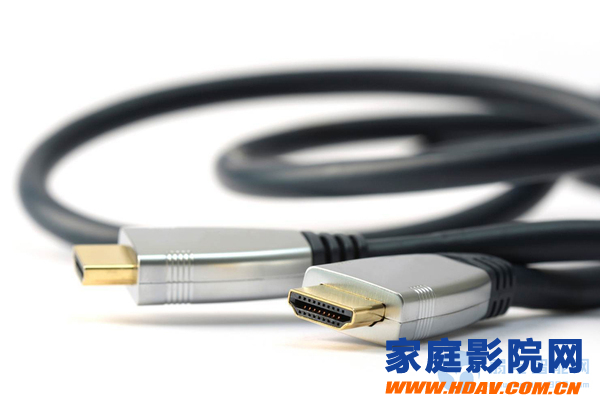
[Home Theater Network HDAV.com.cn] The HDMI Association announced the main technical specifications of the HDMI 2.1 standard, which will be officially announced in the second quarter of 2017. The new standard will support 48Gbps high-speed connection bandwidth and support uncompressed 10K video resolution. Other improvements include image color space to support 16-bit, dynamic HDR technology, and dynamic refresh rates developed for gaming, audio multimedia applications.
The main feature of the HDMI 2.1 standard is that the standard supports more bandwidth than the former. The increase from 18Gbps to 48Gbps can better follow the development of ultra-high-definition TV and display technology, but this requires the use of a new 48G HDMI cable, the new HDMI cable will use the existing A, C and D-type connectors, and Will be backward compatible with existing multimedia devices. The standard 48G HDMI cable is two meters in length and is made of pure copper wire. It is worth noting that many of the features supported by the new HDMI 2.1 standard technical specification require 48G cable, while others do not. Therefore, some features of the new standard may only be supported by some devices, not all devices.
The increased bandwidth of the HDMI 2.1 48G cable will be used for ultra high definition resolutions such as 4K120fps, 8K100/120fps, 10K100/120fps and other formats for video transmission and increased refresh rate. The increased bandwidth also plays a key role in supporting the latest color gamut, such as BT.2020 (Rec. 2020) and 10-bit, 12-bit or even more advanced uncompressed 16-bit color. The HDMI Association does not explicitly state this, but the 2.1 standard will most likely support BT.2100 (Rec. 2100), which has made many important improvements in the technology of BT.2020, especially the high dynamic aspects of the image. Despite HDMI 2.0 and support for BT.2020, and HDMI 2.0B adds support for HDR10 (by Hybrid Logarithmic Gamma Curve (HLG)), existing standards can only transmit 10 bit and 12 bit 4K60fps video. If you want to support 8K HDR high dynamics, you need to use the HDMI 2.1 standard.
In addition, the new HDMI 2.1 standard adds support for dynamic HDR metadata, allowing content producers to control the color, contrast, and brightness of each frame of image. The main part here is that Dynamic HDR will not require a new 48G HDMI cable to handle 4Kp60 resolution video, so manufacturers may be able to add support for dynamic HDR by upgrading the firmware. For many devices today, because display technology is different, many monitors cannot support high dynamic image technology other than HDR10. Also, multimedia video (such as Ultra HD Blu-ray Disc) does not support current HDR, meaning that the two main sources of support for dynamic HDR are probably games, as well as streaming media. It should also be noted that the HDMI Association does not mention how this HDR is implemented, just that the new HDMI 2.1 standard will support some HDR technologies.
| HDMI 2.0 | HDMI 2.1 | |
| Physical bandwidth | 18 Gbps (using high-speed cable) | 18 Gbps (using high-speed cable) 48 Gbps (using 48G cable) |
| Highest resolution | (2D) 4K (4096×2160) @ 60 Hz (4:4:4) | 4K (4096×2160) @ 120 Hz (4:4:4)8K (7680×4320) @ 60Hz (4:4:4)8K (7680×4320) @ 120Hz (4:2:0)10K @ 120Hz ( ?) |
| Maximum depth of field | 48 bits (4K) | 48 bits (8K or more) |
| HDR | Static Static | Dynamic Dynamic |
| Game mode dynamic refresh rate | not support | stand by |
| Object-based multi-channel audio (eARC) | not support | stand by |
In fact, dynamic HDR is not the only feature supported by the new HMDI 2.1 standard for gaming applications. The new standard will also support the game mode variable refresh rate, GM VRR. Today, AMD has supported GM VRR through its own development of FreeSync-over-HDMI. Using the HDMI 2.1 standard will make this feature even easier. The HDMI 2.1 standard 48G cable game analog dynamic refresh can support 4Kp120 and 8Kp60 image resolution. For low resolution/refresh rate applications, the HDMI 1.4 standard cable is sufficient. We don't know if the current GPU and game console can be upgraded to support the HMDI 2.1 GM VRR function, but the image processor will be supported in the future, as these hardware will usually adopt the latest HDMI 2.1 standard.
In addition to the features mentioned above, the HDMI 2.1 standard supports eARC – supporting object-based multi-channel audio formats. The HDMI Forum does not mention specific brands, but Dolby Atmos and DTS: X seem likely to be supported.
HDMI 2.1 standard users bring some long-awaited features, some of which will soon be adopted by new products, and other features may be used in the next few years. The HDMI Forum plans to release the final standard in the second quarter of 2017 and release the HDMI 2.1 conformance test specification in the third quarter. In other words, don't expect to have products that support the new specification in the second half of this year (more likely in 2018) See new products that support the HDMI 2.1 standard). At the same time, from an licensing perspective, any company with an HDMI 2.0 license can get a blueprint for the HDMI 2.1 development plan.
More fresh and fun home theater information, please pay attention to home theater network http:// (WeChat: cnhifi), the country's most influential home theater audio player interactive media website.
Sewing Machine Motor,Dc Motor Sewing Machine,Industrial Sewing Machine,Brushless Servo Motor
LISHUI SHUANGZHENG MOTOR CO.,LTD. , https://www.szservomotor.com
